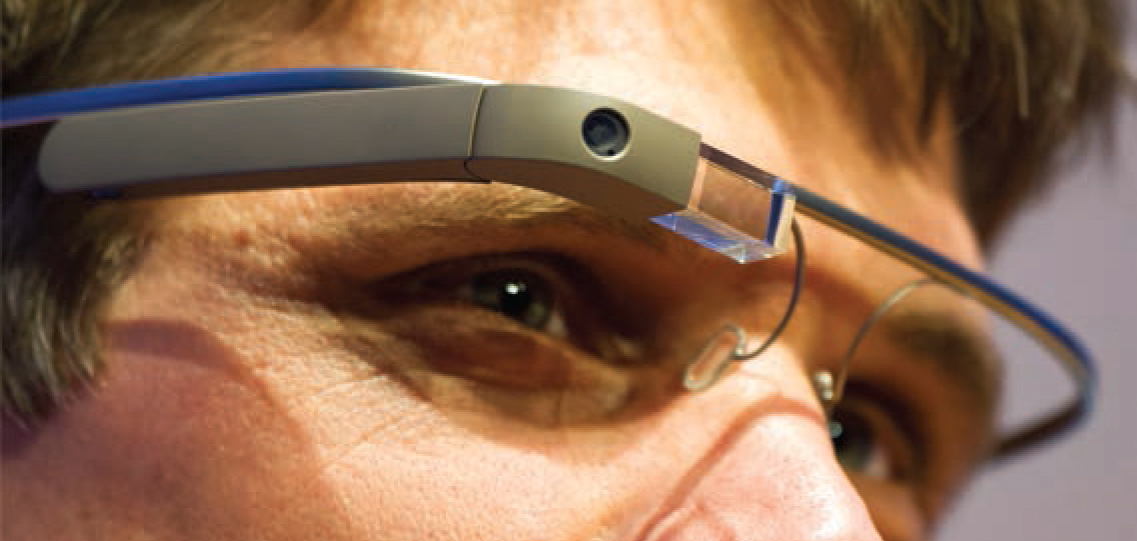
Google’s new Glass technology may make the wearer think they are looking through the eyes of Predator, but the light, wearable, hands-free head gear opens up a world of mobile possibilities that is only just becoming apparent.
100 : Crystal ball

Google’s new Glass technology may make the wearer think they are looking through the eyes of Predator, but the light, wearable, hands-free head gear opens up a world of mobile possibilities that is only just becoming apparent.
Even a cursory glance back through the objects in this book will give the impression that the technology of birding has produced an ever-faster rate of invention and innovation. Looking into this last object, our hypothetical crystal ball, there is no reason to think that this will stop soon.
Further evolution of nanotechnology, already so important in bird migration studies, will lead to ever-tinier transmitters – for example, the storage of data within man-made DNA molecules is now possible. The application of graphene-based technology is also in its infancy, and a layer of graphite just one atom thick can be used as a flexible, wearable, virtually invisible and weightless sheet, potentially revolutionising the dimensions, frequencies and power usage of devices including radio and satellite tags.
Radio frequency identification tags are already small enough to be attached to bees, with 2mm aerial-bearing chips now available; the weight and inconvenience of these to a bird is negligible. The Global System for Mobile Communication has potential to track birds and communicate directly with mobile phones, relaying co-ordinates and climatic and directional information direct to project teams; it could even enable experimental manipulation of the subject itself.
Video cameras are now small enough to attach to birds, and continuing miniaturisation will herald an expansion in their use. Dramatic examples of back-mounted video footage have been televised in BBC TV’s Earthflight, but the novelty belies the scientific applications. Small cameras have already been used to record previously unknown tool-use in New Caledonian Crow.
Owners of iPhones and Android mobiles are enjoying an increasing range of gadgets for their devices’ ever-more sophisticated built-in cameras, including digiscoping adaptors and zoom lenses. With each new model, handset technology continues to develop, and with increasing capacity for apps, data storage and software, could it eventually be possible for a smartphone to replace optics, camera, notebook, field guide, sound recorder, bird news service and even an expert human guide?
This last possibility is not as far-fetched as it sounds. Mobile internet use is set to be revolutionised by Google Glass technology, allowing the wearer of web-enabled spectacles to record images and access the internet – shape and colour recognition programs could become available to compare live image feeds with stored information on bird species and confirm identification. It’s not a huge leap of imagination from music recognition software such as Spooky and Shazam, the likes of which could also be developed to recognise bird songs and calls while listening ‘live’.
Bird identification may also be revolutionised in other ways. Portable DNA testers are now available to identify genetic specimens in the field. Tablet computer-sized biosensor devices have been developed to identify infectious diseases like Ash Dieback and H5N1 within 30 minutes, while the Minion is the size of a large USB memory stick, holds a DNA specimen for sequencing and can be plugged into a laptop for analysis.
Future developments in birding extend beyond the technical to the commercial. In conservation, the Worldwide Fund for Nature (WWF) launched the very first conservation mobile network at the end of January 2013 – WWF Wildlife Mobile gives 10 per cent of net call revenues to conservation, which is ideal for the growing number of people with an interest in, or a concern for, the environment.
Conservation charity credit cards have long been marketed by the RSPB and others, but financial business models may be applied and perhaps we will be buying many of our daily consumable products from suppliers that are actually front-end distributors for charities.
What of birders themselves? The threat of environmental catastrophe predicted by scientists has created acute awareness of the problems facing birds globally. Anticipated extinctions are a driver to see – and try to save – vanishing species such as the Spoon-billed Sandpiper while there is still the chance.
At the other end of the scale, there are those outside the worlds of listing and environmental activism who simply thrive on the more aesthetic enjoyment of their local birds. Whether it takes the form of feeding garden birds or systematically recording the species of a local patch, the importance of this cannot be underestimated. If the huge and growing numbers of households taking part in the RSPB’s annual Big Garden Birdwatch is a fair indicator, this trend looks set to continue. It is also possible to imagine a reaction against the array of technology into analog birding, where expertise and skill are measured and respected by their ability to find and identify birds all by themselves, old school style. You know – what used to be called ‘birdwatching’.